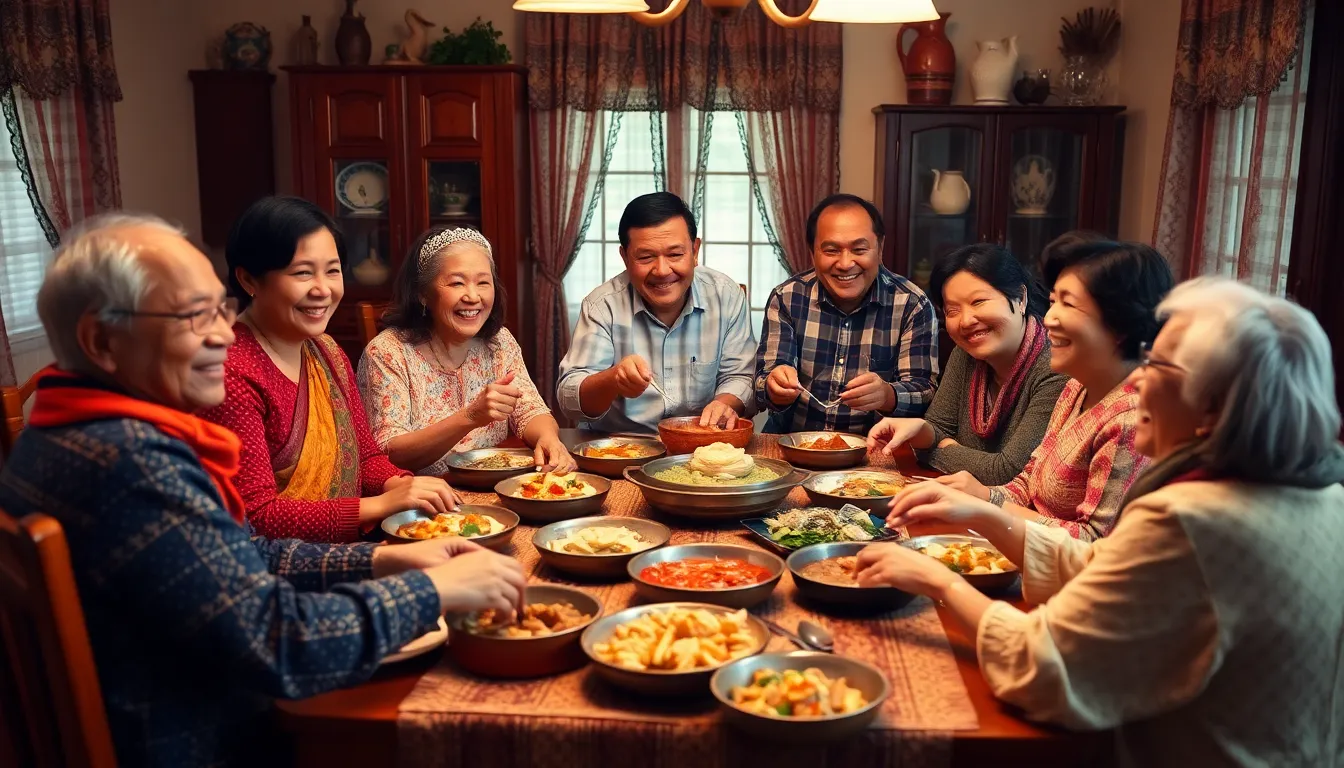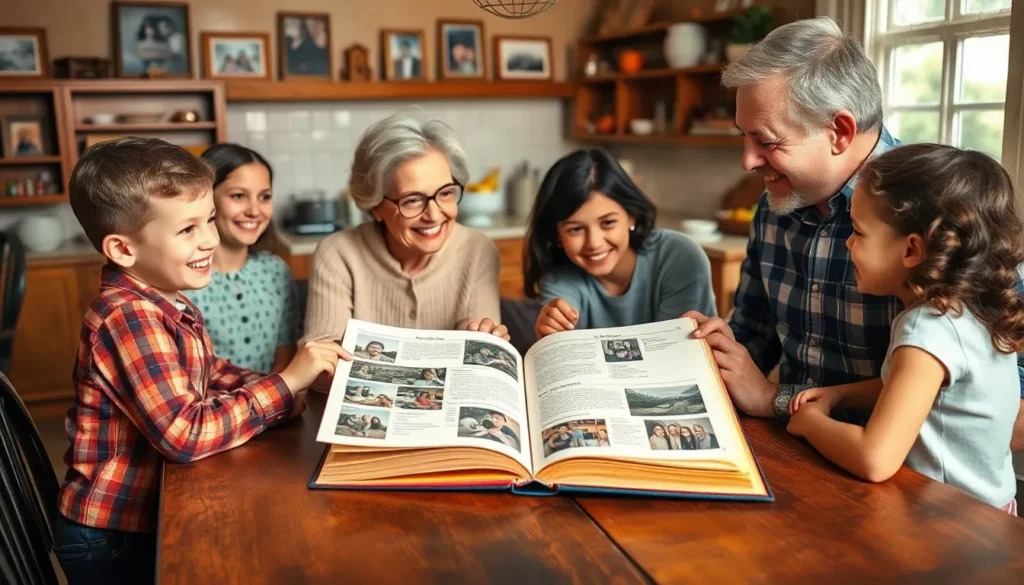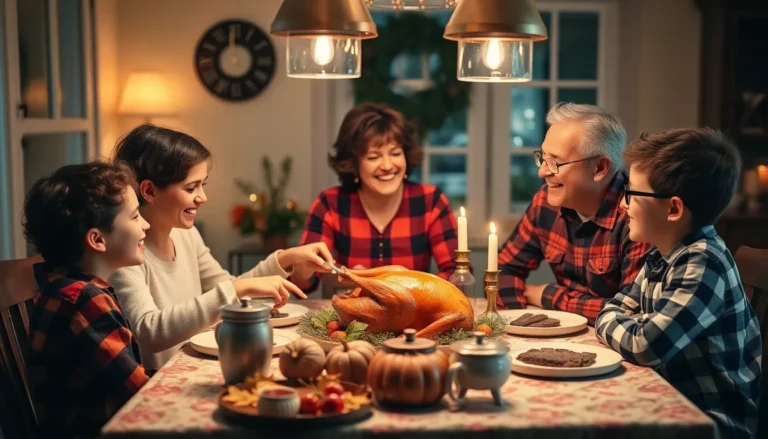Table of Contents
ToggleIn a world where family gatherings often turn into chaotic sitcom episodes, a family customs book can be the ultimate lifesaver. Imagine flipping through pages filled with cherished traditions, quirky anecdotes, and recipes that could make even the pickiest eater reconsider their life choices. This isn’t just a book; it’s a treasure trove of memories waiting to be documented and shared.
Overview of Family Customs Books
Family customs books serve as treasured collections of shared experiences and traditions. These books capture a family’s unique history and showcase values passed down through generations. Organizing recipes, stories, and traditions within their pages fosters a sense of belonging among family members. Many families include special photographs and artistic elements, enhancing the book’s visual appeal.
Families often find joy in compiling contributions from various members. Children, grandparents, and parents each bring their perspective, making the book a collaborative effort. Documenting humorous anecdotes and personal memories creates a vivid narrative that encapsulates family identity. Each entry reflects the distinct personality of the family, highlighting cherished moments and specific cultural practices.
Interest in family customs books grows with increased awareness of heritage preservation. Individuals seek to connect with their roots while sharing the traditions that define them. Customizing the layout and content further personalizes each book. Themes might revolve around holidays, life milestones, or regional customs.
Including recipes positions the family customs book as a practical resource. Detailed instructions invite family members to recreate favorite dishes, sharing flavors that invoke nostalgia. Many families enjoy hosting gatherings where they prepare and taste these dishes, establishing a deeper connection to their culinary heritage.
Understanding the significance of these books enables families to treasure their legacies. A family customs book becomes more than just a collection; it transforms into a living testament that honors the emotions and memories that bind family members together. It’s an essential tool for nurturing connections and celebrating cultural diversity.
Importance of Family Customs

Family customs play a significant role in shaping familial bonds and preserving traditions. Through shared practices, families create lasting connections that enrich their histories.
Cultural Heritage
Cultural heritage finds expression through family customs. Unique traditions reflect the values and beliefs specific to each family. Celebrating holidays with particular rituals or preparing traditional dishes highlights cultural identities. These customs provide families a means to pass down legacies, allowing younger generations to engage with their heritage. Examples of cultural practices include storytelling, music, or dance that resonate deeply within a family. Reinforcing these traditions fosters pride among family members. When they participate, they build a sense of belonging and continuity.
Identity Formation
Identity formation often hinges on family customs. Engaging in shared traditions helps individuals understand their roots. Personal stories, traditions, and values contribute to each person’s sense of self. Children often find their place within the family narrative through participation in customs. They learn about resilience, love, and unity from the stories and rituals passed down. For instance, family reunions or cooking certain recipes can solidify a child’s connection to their family history. By incorporating shared experiences, families shape personal identities and cultivate a strong familial heritage.
Key Themes in Family Customs Books
Family customs books highlight significant themes that bind generations together. These themes include traditions and rituals as well as storytelling and ancestry, both central to preserving family narratives.
Traditions and Rituals
Traditions unite family members by creating shared experiences. Observing holidays, birthdays, and other special events captures the essence of family identity. These customs often include specific rituals, like family prayers or unique ways of celebrating milestones. Families document these practices to ensure they persist through generations. Recording recipes associated with these gatherings enhances the connection to culinary heritage. Families can recreate beloved dishes together, allowing younger members to appreciate their history. Emphasizing these traditions fosters appreciation and strengthens familial bonds, reinforcing cultural pride.
Storytelling and Ancestry
Storytelling plays an essential role in preserving family history. Narratives passed down through generations provide context and meaning to family customs. Anecdotes illustrate shared experiences, helping members connect with their ancestry. By including stories from grandparents and parents, family customs books become rich in personal anecdotes. Illustrating the family’s unique journey allows younger generations to understand their roots. Such connections foster a sense of belonging and identity. Through storytelling, family members learn resilience and unity, strengthening ties and celebrating their cultural heritage.
Recommended Family Customs Books
Family customs books offer rich insights into traditions and shared memories. The following selections provide valuable resources for families looking to document their legacies.
Contemporary Selections
“Family Recipe Journal” by J. Smith features ample space for recipes and family stories, bridging generations. This practical book encourages families to gather their favorite dishes and create a lasting culinary archive. “My Family Traditions” by K. Johnson focuses on personal anecdotes, inviting each family member to contribute distinctive memories. Modern families appreciate its conversational style, making it easy to engage all ages. “Heritage Cookbook” by L. Martinez combines recipes with cultural insights, allowing families to explore their roots while cooking together.
Classic Titles
“Home Cooking” by A. Child remains a beloved staple for family recipe collections. This classic cookbook emphasizes traditional meals, ensuring family favorites are preserved for future generations. “Betty Crocker’s Cookbook” features timeless recipes while including sections on family gatherings, enhancing the shared cooking experience. “The Joy of Cooking” by I. Rombauer is renowned for its comprehensive guidance, offering something for everyone within the family. Each title fosters connections through food and memories, reinforcing the importance of family heritage.
How to Choose the Right Family Customs Book
Selecting the appropriate family customs book involves several key factors. Consider the book’s theme and focus, as this shapes which aspects of family life to highlight. Popular themes include culinary heritage, holiday traditions, and personal stories, allowing families to customize their own narratives.
Assess the layout and design options available. Some books offer guided prompts, while others provide blank pages for free expression. Choose a format that matches your family’s storytelling style and encourages contributions from all members.
Examine the author’s background and expertise. Books by recognized culinary enthusiasts or cultural historians often offer deeper insights into traditions and recipes. Well-researched titles enhance the significance of the information presented.
Evaluate how well the book facilitates collaboration among family members. Titles that encourage contributions from children, parents, and grandparents foster rich storytelling and diverse perspectives. A collective approach strengthens the family bond and enhances individual narratives.
Investigate reviews and recommendations to gauge the book’s effectiveness. Seek out testimonials from families who have used the book to document their customs. Positive feedback can inform your decision and help identify the most suitable options.
Look for flexibility in content. Some family customs books allow for the addition of personal anecdotes, photographs, and illustrations. This adaptability encourages families to create a unique representation of their heritage.
Identify any special features that might enrich the experience. Some books include pockets for keepsakes or QR codes linking to recipes online. Innovative elements enhance the user’s journey into their family’s history.
By prioritizing these factors, families can select a customs book that becomes a cherished collection of traditions, recipes, and memories.
A family customs book serves as a vital link between generations. It captures the essence of shared experiences and cherished traditions that define a family’s identity. By preserving recipes and personal anecdotes, it fosters a sense of belonging and connection among family members.
As families explore their heritage through storytelling and culinary practices, they not only celebrate their past but also create lasting memories for future generations. Investing time in compiling a family customs book enriches relationships and strengthens familial bonds. Ultimately, it becomes a treasured keepsake that honors the love and unity that bind families together.







